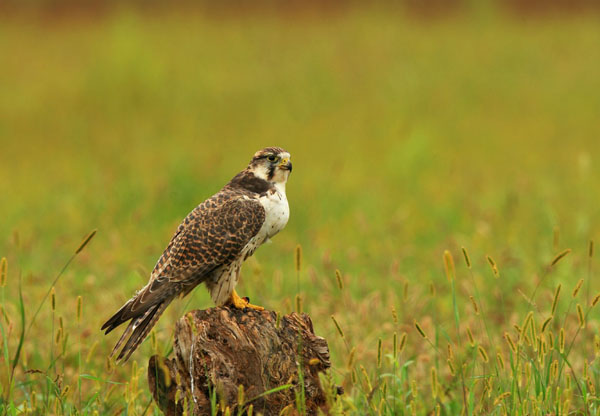Falco cherrug
IUCN
LCBasic Information
Scientific classification
- name:Falco cherrug
- Scientific Name:Falcon, Stick
- Outline:Raptor
- Family:Falconiformes Falconidae Falco
Vital signs
- length:278-779mm
- Weight:510-1200g
- lifetime:33year
Feature
The hunting falcon is a bird of prey deeply loved by the Mongolian people and is the "national bird" of Mongolia.
Distribution and Habitat
Saker falcons are distributed in Eastern Europe, the Middle East, Central Asia and southern Siberia, and winter in central and western China, the Middle East, West Asia, northern India and eastern Africa. They are found in Xinjiang in the northwest, Inner Mongolia, Liaoning, Jilin, Beijing, Hebei, Henan in the north, Gansu, Qinghai, Sichuan, Tibet in the west, and occasionally in the east.
Saker falcons mostly live in plains, plateaus, high-altitude mountains, semi-deserts, and habitats with many cliffs and rocks. They are commonly found in areas below 2,000 meters above sea level, and can reach up to 4,700 meters.
Appearance
The Saker Falcon is a large, light-colored falcon with a thick chest. The nape is whitish and the top of the head is light brown. The head has little contrasting color, with an indistinct black line under the eye and a white eyebrow. The upper body is mostly brown with slight horizontal stripes, which contrasts with the dark brown wing tips. The tail has narrow white feather tips. The lower body is whitish, with narrow dark wing tips and large underwing coverts with fine black stripes. The wings are blunter and lighter than those of the Peregrine Falcon. Juveniles have dark brown upper bodies and black vertical stripes on the lower body. The call is similar to that of the Peregrine Falcon but hoarser.
Males and females are monotypic. There are no obvious wing fingers. The color depth varies greatly depending on the individual. The beak and claws are smaller than those of the Peregrine Falcon. It is easier to confuse with the gray type of the Peregrine Falcon, the difference is t
Details
Falcons feed on birds, rodents and mammals, and are capable of hunting medium to large birds, including waders, waterfowl, land birds, and sturdy small animals. They can hunt on the ground and in the air, are aggressive, and will actively drive away other raptors approaching their territory, such as golden eagles. Whenever they find prey on the ground, falcons always use their narrow wings that can reduce resistance like a high-speed aircraft to fly above the prey and occupy the commanding heights, then fold their wings so that the flight feathers on the wings are parallel to the longitudinal axis of the body, and retract their heads to their shoulders, rushing towards the prey at a speed of 75-100 meters per second at a 25-degree angle. At the moment of approaching the prey, they slightly open their wings and strike or grab the prey with their hind toes and claws.

In addition, it can also attack flying tits, larks and other small birds in the air like a fighter jet. After catching up with the prey, it will use its wings to hit it until the prey loses the ability to fly and falls from the air, and then dive down to capture it.

This species has strong hunting ability and has been a hunting tool highly praised by northern ethnic groups and Middle Eastern countries since ancient times.
Falcons are easy to tame and are good hunting tools after being tamed. Hunters have tamed falcons throughout history. In Arab countries, taming falcons is still a symbol of fashion, wealth and status. The international falcon trade has caused this species to be captured to extinction in many of its natural distribution areas. In our country, there are also criminals who illegally capture falcons for smuggling activities.








